

Pit Greenhouses. Pit Greenhouses Depending on latitude, but despite above ground air temperatures (and wind chill), 6 to 8 feet down into the earth, temperatures remain fairly constant, between 50 and 60°F.
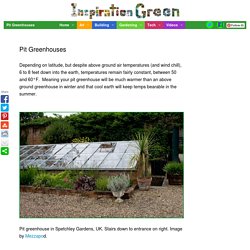
Meaning your pit greenhouse will be much warmer than an above ground greenhouse in winter and that cool earth will keep temps bearable in the summer. Pit greenhouse in Spetchley Gardens, UK. Stairs down to entrance on right. Floating GrowOnUs water-filtering garden pops up on the Gowanus Canal. Made possible through a $20,000 grant from the Cornelia & Michael Bessie Foundation, GrowOnUs is the latest manifestation in Balmori’s series of water-purifying infrastructures throughout the city.

The firm is also interested in seeing how the filter-like gardens can generate income by producing edible plants. “We have pioneered floating landscapes, we now want to learn what can make these floating structures financially sustainable,” said Balmori Associates founder Diane Balmori. “Dr. Michael Balick at the New York Botanical Garden suggested we grow herbs, low maintenance crops that can give a financial return given their price per volume.
Videos, Voices & Words Inspiring Global Citizens. The lake Baikal seal: an evolutive biogeographic mystery ? Lake Baikal It is the “pearl of Siberia”, so named for its beauty and nature.
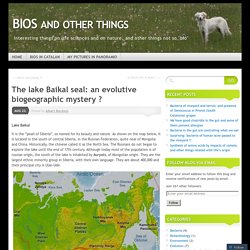
As shown on the map below, it is located in the south of central Siberia, in the Russian Federation, quite near of Mongolia and China. Historically, the chinese called it as the North Sea. The Russians do not began to explore the lake until the end of 17th century. Freshwater Lake Baikal seal videos, photos and facts - Pusa sibirica.
Seawater greenhouse. A seawater greenhouse is a greenhouse structure that enables the growth of crops in arid regions, using seawater and solar energy.
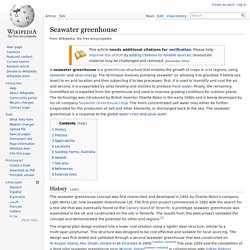
The technique involves pumping seawater (or allowing it to gravitate if below sea level) to an arid location and then subjecting it to two processes: first, it is used to humidify and cool the air, and second, it is evaporated by solar heating and distilled to produce fresh water. Finally, the remaining humidified air is expelled from the greenhouse and used to improve growing conditions for outdoor plants.
Rice Beds Rebound In Northern Wisconsin Lake Following Efforts To Rein In Carp. How to make a DIY natural swimming pool. David Pagan Butler introduces how to make a natural swimming pool -- no chemicals, just aquatic plants and a simple 12 volt powered filter to clean the water -- and shows you how to make your own from recycled materials for a fraction of the cost of one installed by a professional contractor.
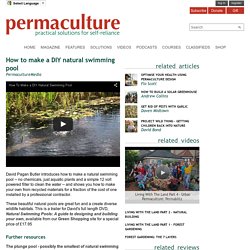
These beautiful natural pools are great fun and a create diverse wildlife habitats. This is a trailer for David's full length DVD, Natural Swimming Pools: A guide to designing and building your own, available from our Green Shopping site for a special price of £17.95 Further resources The plunge pool - possibly the smallest of natural swimming pools A case study into the positive effects of a natural swimming pool Exclusive content and FREE digital access to over 20 years of back issues. Award Winning English Greenhouses - Hartley Botanic US. Feeds aquatic plants. 10 39 water mimosa. Water mimosa (Neptunia oleracea) - AVRDC - The World Vegetable Center - avrdc.org. Plants for Ponds & Water Gardens: Variegated Water Celery. Overview Variegated Water Celery is a colorful, low spreading plant typically planted in water gardens partially submerged at the margins.
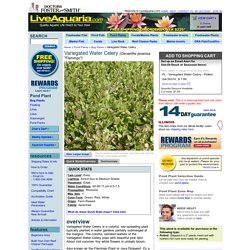
The colorful, serrated leaflets of the Variegated Water Celery pops with beautiful pink tips! About mid summer, tiny white flowers in umbels bloom. Water Celery. Canvasbacks, Red heads, Blue bills, Mallards and may other wild ducks, darken the sky in the fall over the wild celery beds.
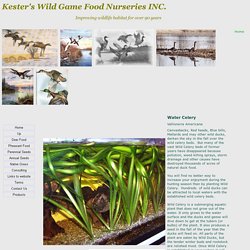
Sweet Flag. Acorus americanus range map.
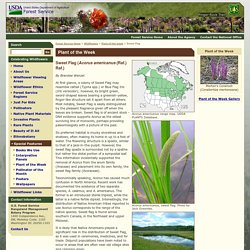
USDA PLANTS Database. Acorus americanus, sweet flag. Photo by Jack Greenlee. Typical sweet flag wetland habitat. Acorus calamus... How to Plant Wild Rice for Ducks. HANDBOOK OF UTILIZATION OF AQUATIC PLANTS. This is probably the most important chapter in this handbook.
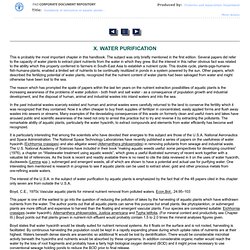
The subject was only briefly mentioned in the first edition. Several papers did refer to the capacity of water plants to extract plant nutrients from the water in which they grew. But the interest in this rather obvious fact was related to the ability which this property conferred to farmers in South-East Asia to establish a nutrient cycle. This double cycle, plants-pigs-humans-fish-humans-plants, enabled a limited set of nutrients to be continually reutilized in ponds in a system powered by the sun. Aquaculture (Plants) Floating Plant Ponds Commonly used plants in floating plant ponds are water hyacinths and duckweed.
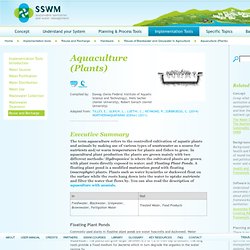
Water hyacinths are perennial, freshwater, aquatic macrophytes that grow especially fast in wastewater. The plants can grow large: between 0.5 to 1.2 m from top to bottom. The long roots provide a fixed medium for bacteria which in turn degrade the organics in the water passing by. Duckweed is a fast growing, high protein plant that can be used fresh or dried as a food for fish or poultry.
Functional schematic of a floating plant pond. Winter Tip for Your Pond. Biology of the Northern Crayfish (Orconectes virilis) Description Crayfish, of which our own Northern Crayfish (Orconectes virilis) is one of about 500 species worldwide, are crustaceans related to copepods, barnacles, crabs, shrimps, lobsters, etc.
Northern Crawdad.